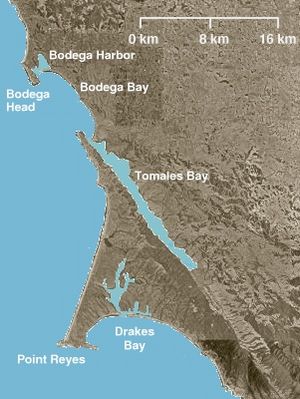- This page was last modified on 17 October 2025, at 10:18. Suggest an edit.
Estero de Limantour State Marine Reserve & Drakes Estero State Marine Conservation Area facts for kids
Estero de Limantour State Marine Reserve (SMR) and Drakes Estero State Marine Conservation Area (SMCA) are two special ocean areas. They are located next to each other along the Point Reyes National Seashore in Marin County, California. These areas help protect the amazing sea life and habitats found there.
Together, these protected areas cover about 4.04 square miles (10.46 square kilometers). The Estero de Limantour SMR is about 1.49 square miles (3.86 square kilometers). The Drakes Estero SMCA is about 2.55 square miles (6.60 square kilometers). In Drakes Estero SMCA, people are not allowed to take any living sea creatures. However, you can collect clams for fun.
Contents
History of These Protected Areas
Estero de Limantour SMR and Drakes Estero SMCA are part of a bigger plan. They are two of 22 marine protected areas created by the California Department of Fish and Game. This happened in August 2009. These areas were set up during the second phase of the Marine Life Protection Act Initiative.
The Marine Life Protection Act Initiative is a big project. It brings together many people to create a network of protected ocean areas. This network stretches all along California's coastline.
Who Designed the Protected Areas?
Local people helped design these special ocean areas. Divers, fishermen, conservationists, and scientists worked together. They formed a group called the North Central Coast Regional Stakeholder Group. Their main goal was to protect sensitive sea life and their homes. They also wanted to make sure people could still enjoy the ocean. This included activities like recreation, study, and learning.
The new marine protected areas along California's north central coast officially started on May 1, 2010.
Geography and Natural Features
Estero de Limantour SMR and Drakes Estero SMCA are side-by-side. They are located within the Point Reyes National Seashore in Marin County, California. The Estero de Limantour SMR is also connected to the Point Reyes State Marine Reserve. Point Reyes is a stunning peninsula. It is known for its rich variety of plants and animals. It has been named a National Seashore.
What is Estero de Limantour SMR?
Estero de Limantour SMR includes the waters inside Estero de Limantour. These are the waters below the average high tide line.
What is Drakes Estero SMCA?
Drakes Estero SMCA includes the waters inside Drakes Estero. These are also the waters below the average high tide line.
Ocean Life and Habitats
Estero de Limantour and Drakes Estero are very important places for ocean animals. They act like nurseries for young Dungeness crabs and many types of fish. These areas are also safe spots for seals to have their babies. Marine mammals use them as resting places.
Many animals come here to find food. This includes leopard sharks, bat rays, and lots of different bird species. The Estero de Limantour SMR and Drakes Estero SMCA protect special habitats. These include beds of eelgrass and muddy areas called mudflats. They also help keep major seabird colonies and elephant seal groups safe from being disturbed.
Fun Activities and Nearby Places
Imagine a misty, salty fog. Through it, you can hear and feel the powerful ocean waves. They crash onto long sandy beaches and rocky cliffs. The Point Reyes National Seashore is a huge area. It covers over 100 square miles (259 square kilometers). About 33,300 acres (135 square kilometers) of it is wild coastal land. The undeveloped coastline stretches for 80 miles (129 kilometers).
There are many fun things to do here. You can go hiking, biking, kayaking, and camping. It's also a great place to watch wildlife. There are three visitor centers. You can also join many programs led by park rangers.
What You Can and Cannot Do
In Estero de Limantour SMR, you are not allowed to take any living sea creatures. In Drakes Estero SMCA, you can collect clams for fun. However, you cannot take other living marine resources.
California's marine protected areas want people to enjoy the ocean. They encourage activities like kayaking, diving, snorkeling, and swimming. These activities are usually allowed unless there are other specific rules.
Scientific Monitoring
Scientists are studying some of California's marine protected areas. This is part of the Marine Life Protection Act. They want to see how well these areas are working. They also want to learn more about the health of our oceans.
Similar studies have been done in other protected areas. For example, near the Santa Barbara Channel Islands. These studies have already shown good results. The fish there are slowly getting bigger and more numerous.

